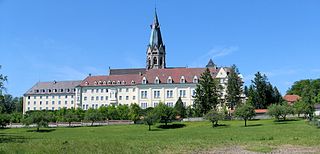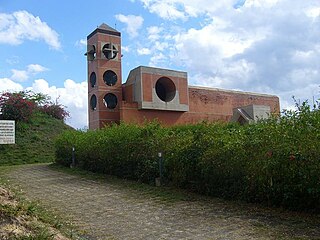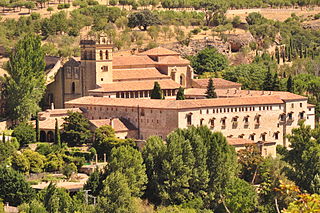
St. Ottilien Archabbey is a Benedictine monastery in Emming near Eresing and the Ammersee in the district of Landsberg, Oberbayern, Germany. It is the mother house of the St. Ottilien Congregation, otherwise known as the Missionary Benedictines.

The Ottilien Congregation, often also known as the St. Ottilien Congregation and as the Missionary Benedictines, is a congregation of religious houses within the Benedictine Confederation, the aim of which is to combine the Benedictine way of life with activity in the mission field.

San José Abbey, Güigüe, Venezuela, is a Benedictine abbey of the Congregation of Missionary Benedictines of Saint Ottilien. Currently located to the south of Lago de Valencia, the monastic community was originally established as a mission procure in Caracas following World War I. Caracas' expansion restrained the development of the abbey, and in the late 1980s the monks relocated to Güigüe. The community's superior is Fr Abbot José María Martínez Barrera.

Tokwon Abbey was a Benedictine monastery of the Congregation of Missionary Benedictines of Saint Ottilien, located near the town of Wonsan in what is now North Korea. Founded as a monastic mission in Seoul, the community transferred to Tokwon in the 1920s to take charge of the newly created Apostolic Vicariate of Wonsan. The persecution of Christians in North Korea since 1949 made any church activity in the abbacy impossible. However the Territorial Abbacy of Tokwon is formally still kept as one of the few remaining territorial abbeys within the Catholic Church.

Christ the King Priory is a monastery of Benedictine monks located north of Schuyler, Nebraska, United States. It is a simple priory of the Congregation of Missionary Benedictines of Saint Ottilien, part of the Benedictine Confederation.

The Abbey of Our Lady Help of Christians, Ndanda, Tanzania, is a Benedictine monastery of the Congregation of the Missionary Benedictines of Saint Ottilien. Established in 1906 as a mission station in German East Africa, the monastery is currently home to 71 monks. On 4 July 2015 the community elected Fr. Placidus Mtunguja OSB its 5th Abbot.

St Paul's Abbey, Newton, New Jersey, is a Benedictine simple priory of the Congregation of Missionary Benedictines of Saint Ottilien. Originally established as a mission procure following World War I, over time the size of the community drastically decreased. In 2002, monks from Waegwan Abbey, South Korea, took charge of the monastery. On January 25, 2004, Newton II was elevated to the status of a simple priory. The community's superior is Fr Prior Samuel Kim.
Prince of Peace Conventual Priory, Tigoni, Nairobi Province, Kenya, is a Benedictine monastery of the Congregation of the Missionary Benedictines of Saint Ottilien. Established in 1978 at the request of Maurice Cardinal Otunga, the monastery is currently home to 35 monks. Conventual Prior Lawrence Mukuru Emukule is the community's superior.
Incarnation Conventual Priory, Agbang, Kara, Togo, is a Benedictine monastery of the Congregation of the Missionary Benedictines of Saint Ottilien. Established in 1985 by Frère Boniface Tiguila, the monastery is currently home to 28 monks. Conventual Prior Fr Bernard Anaté is the community's superior.
Christ the King Priory, Tororo, Eastern Region, Uganda, is a Benedictine monastery of the Congregation of Missionary Benedictines of Saint Ottilien. Established in the 1980s by Fr John Neudegger, OSB, the monastery is currently home to 24 monks. Fr Prior Edward Etengu is the community's superior.
St Michael's Priory, Kumily, Idukki, Kerala, India, is a Benedictine monastery of the Congregation of the Missionary Benedictines of Saint Ottilien. The monastery was established in 1987 by Zacharias Kuruppacheril, an Indian secular priest. Located on the western slopes of the Cardamom Hills, around 150 km east of Kochi, the monastery is currently home to 13 monks and 6 brothers in formation. Prior Fr.John Kaippallimyalil is the community's superior.
St Benedict's Conventual Priory, Digos, Davao del Sur, Philippines, is a Benedictine monastery of the Congregation of Missionary Benedictines of Saint Ottilien. Established in 1983 at the request of Bishop Generoso Camiña of the Diocese of Digos, the monastery is currently home to 21 monks. Conventual Priory Fr Edgar Friedmann is the community's superior.
The Abbey of St. Maurus is a Tanzanian Benedictine monastery of the Congregation of Missionary Benedictines of Saint Ottilien in Hanga, Ruvuma Region. Established in 1956 by Abbot-Bishop Eberhard Spiess as a formation house for African monastic candidates, the monastery is currently home to 122 monks. The abbey operates schools and a dispensary for the people of the local village and a seminary for the Roman Catholic Archdiocese of Songea.

St Maurus and St Placidus Abbey, Waegwan, Chilgok, North Gyeongsang, South Korea is a Benedictine monastery of the Congregation of Missionary Benedictines of Saint Ottilien. Established in 1952 by Korean monks who had survived the dissolution of St Benedict's Abbey, Tokwon, and Holy Cross Abbey, Yanji, the monastery is currently home to 131 monks. Abbot Fr Blasio Park is the community's superior.
The Monastery of St Odile, Malandji (Kananga), Kasaï Occidental province, Democratic Republic of the Congo, was a Benedictine monastery of the Congregation of Missionary Benedictines of Saint Ottilien. Established in Zaïre in 1990 by two members of St Ottilien Archabbey, the monastery was suppressed in 1996 during the First Congo War.
Holy Cross Abbey, Yenki (Yanji), Jilin, China, was a Benedictine monastery of the Congregation of Missionary Benedictines of Saint Ottilien. Established in 1922 as a mission station, the monastery later became the seat of the Vicariate Apostolic of Yenki. After the withdrawal of Soviet forces following World War II, the monastery was suppressed by the People's Republic of China. While many of the monks were repatriated to Europe, others moved to South Korea and founded the Abbey of Waegwan.
Monastère Notre-Dame-des-Sources, Kiswishi, Lubumbashi, Democratic Republic of the Congo, is a Benedictine monastery of the Annunciation Congregation. Established in 1944 in Katanga Province, the monastic community was relocated to Kiswishi (Kisuishi), around 17 km from Lubumbashi, in the early 1960s. As of 2000, the monastery was home to 39 monks, under the leadership of Conventual Prior Fr Boniface N'Kulu Lupitshi.
St Benedict's Abbey, Pietersburg (Polokwane), Limpopo, South Africa, is a Benedictine monastery of the Subiaco Congregation. It began in 1911 as a mission territory; the community established a monastery in 1937. As an Abbey Nullius, the monastery governed what is now the Roman Catholic Diocese of Polokwane until 1989. As of 2013, the community numbers 16 in various stages of formation monks, under the leadership of Prior Administrator Jeffrey Steele.
Abadía de San Benito, Luján, Buenos Aires Province, Argentina, is a Benedictine monastery of the Cono-Sur Congregation. Originally established in Buenos Aires, the monastery became an abbey in 1950 and later transferred to the outskirts of Luján. As of 2000, the monastery was home to 13 monks, under the leadership of Abbot Fr Fernando Ricas.















